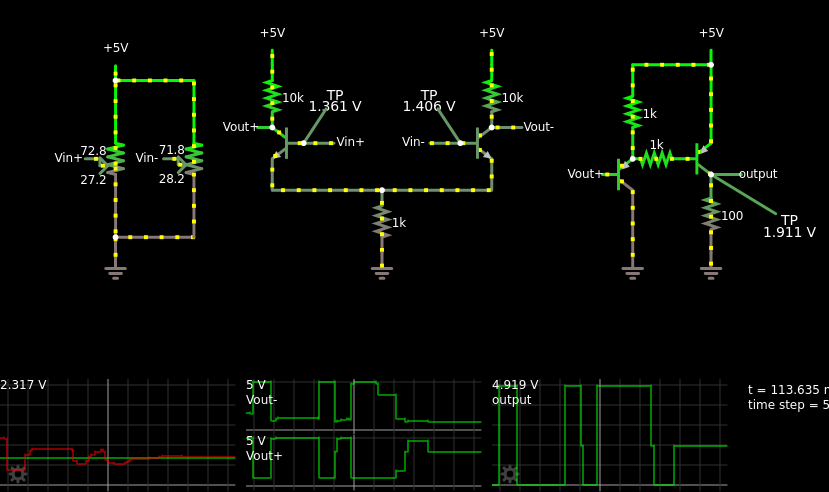
It’s been Norbert Wiener’s birthday today, and although he wasn’t the inventor of the op-amp, he was the key person in explaining the significance of the op-amp and similar things. So I thought I’d celebrate by building my very first op-amp. If I could.
I got a four-transistor circuit working in Falstad’s circuit simulator:

$ 1 0.000005 0.06323366621862497 50 5 50
R 176 208 176 176 0 0 40 5 0 0 0.5
174 176 368 176 208 1 100 0.5693 Vin+
g 176 368 176 400 0
207 160 288 128 288 4 Vin\p
207 368 272 416 272 4 Vin\p
t 368 272 336 272 0 1 0.6109572102548784 0.6310546959814354 100
w 336 288 336 320 0
w 336 320 448 320 0
r 448 320 448 384 0 1000
g 448 384 448 400 0
r 336 256 336 192 0 10000
R 336 192 336 160 0 0 40 5 0 0 0.5
207 336 256 304 256 4 Vout\p
w 176 208 256 208 0
w 176 368 256 368 0
174 256 368 256 208 1 100 0.2822 Vin-
207 240 288 208 288 4 Vin-
t 528 272 560 272 0 1 -3.588999998997953 -0.7590165014195449 100
w 560 288 560 320 0
w 560 320 448 320 0
207 528 272 480 272 4 Vin-
R 560 192 560 160 0 0 40 5 0 0 0.5
r 560 256 560 192 0 10000
207 560 256 608 256 4 Vout-
207 688 304 656 304 4 Vout\p
r 784 384 784 304 0 100
R 784 192 784 160 0 0 40 5 0 0 0.5
g 784 384 784 400 0
207 784 304 832 304 4 output
368 784 304 864 352 0 0
r 752 288 704 288 0 1000
t 752 288 784 288 0 -1 -0.5948957135185378 -0.6972226181259069 100
w 784 272 784 192 0
t 688 304 704 304 0 -1 2.190113987148148 -0.6288987134827844 100
w 784 192 704 192 0
r 704 192 704 288 0 1000
g 704 320 704 400 0
368 528 272 496 224 0 0
368 368 272 400 224 0 0
o 3 1 0 4098 5 0.1 0 2 20 0
o 23 1 0 4098 5 0.1 1 2 23 3 Vout-
o 12 1 0 4098 5 0.1 1 2 12 3 Vout\p
o 28 1 0 4098 5 0.1 2 2 28 3
It seems to have open-loop differential gain of at least 100 and outputs down to the negative rail (“single-supply op-amp”) but it wastes a ridiculous amount of power in its class-A output stage. Also it has an input offset voltage of about 50 mV and an offset current of a couple of milliamps. So it’s not a very good op-amp, but it is an op-amp.
I feel like it ought to be possible to get the output stage down to one transistor instead of two, but I was having a hard time getting that to work (my output stage was loading down the differential pair too much) and so I just brute-forced it with a PNP emitter follower. The emitter-follower loading is still probably the culprit for the rather poor offset voltage.
I haven’t breadboarded it yet, and I had a hard time figuring out why the previous circuit simulation weren’t working, and I’d like to see if I can get the output stage down to one transistor.